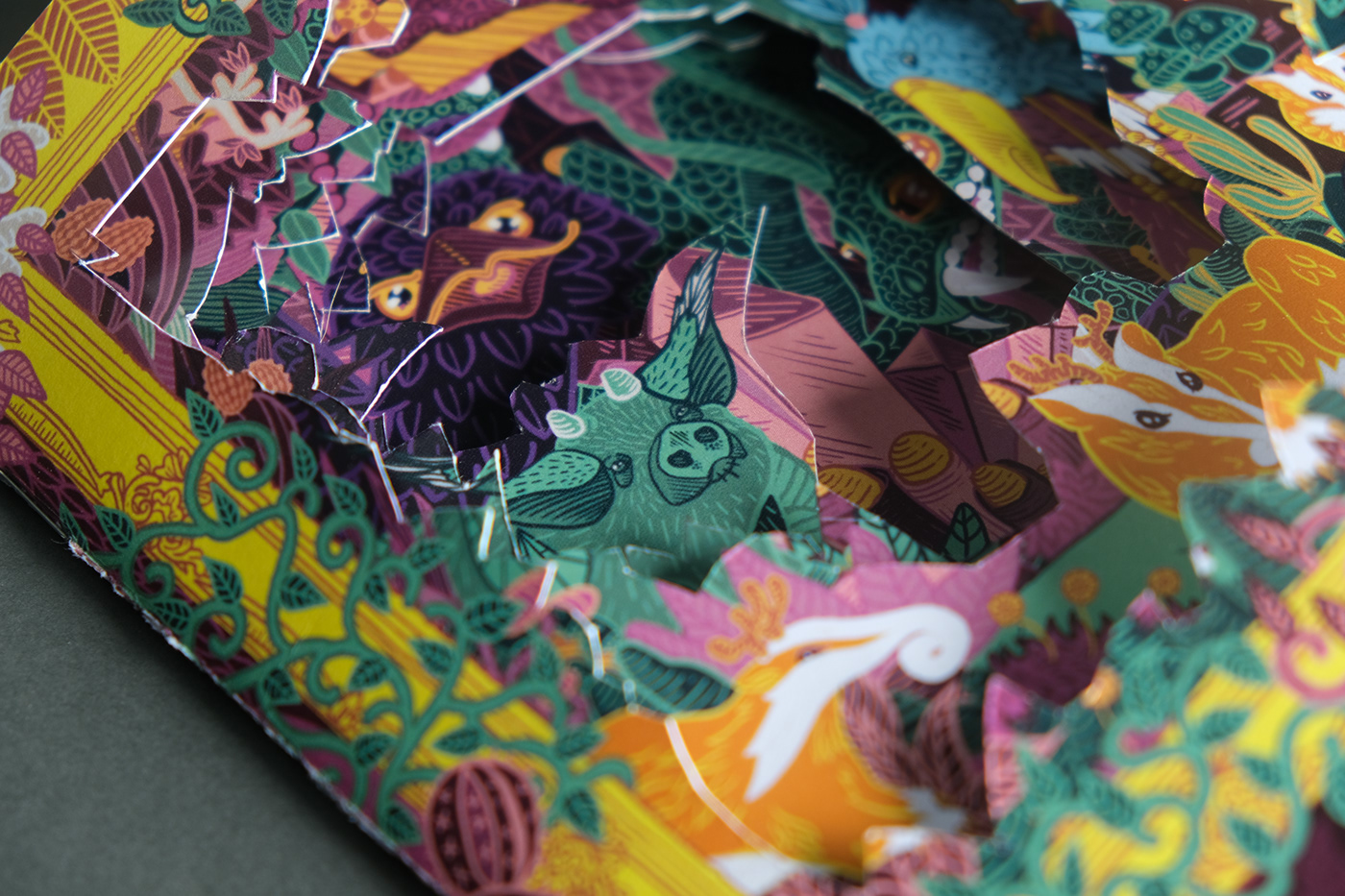Illustration as a pedagogical tool in South African grade 9 poetry studies : Jabberwocky
This project aimed to address the issue of disengagement that Grade 9 learners face when learning poetry employing illustration. One aspect of my argument is that part of the solution to the high drop-out rates is to provide learners with the relevant schematic information which they require to fully engage with the text in the form of images. This allows the learner to access and engage with content they are taught in schools in spite of the language gap present in the South African education system.
My practical component consists of four visual literacy activity packs which accompany the Grade 9 English home language poetry syllabus and act as a tool to create understanding and foster engagement. The practical component acts as a proof of concept of my ideas.
.

The layout of this project was cut out layers which illustrates the layers of time in the narrative of the poem. This provides the learner with the experience of ‘travelling’ through the poem as well as strengthens the theme of the unknown being communicated as with each layer more of the story is revealed.
The flat designs of the booklet:




Imaginary plants have been included in the design of the environments of the imaginary creatures to set the scene that this tale takes place in a fictional world. When creatures which are not part of the learner's regular schematic information are placed within a setting that they are unfamiliar with, the learner is less likely to experience unresolved cognitive dissonance. This allows the learner to immediately understand that the poem is occurring in a world unlike ours and the nonsense can be more easily integrated because there is not an existing schematic structure to conflict with.


As part of the visual literacy activity, the learner is asked to participate in a guided exploration of the visual metaphor by making the borogoves seem miserable and flimsy by pasting the tear stickers onto the page and commenting on the physical stature of the birds. I have illustrated the borogoves in such a way that the intended meaning is clear within the visual metaphor. The learner has a choice on where to place the stickers but they have been designed so that the required placement is obvious by including small snippets of the surrounding image so that the sticker fits into its surroundings. Thus the activities direct the learner’s responses to the questions to standardise the outcomes even though the learner thinks they are exploring and creating something new.








Onomatopoeia is represented in the image above using the visual metaphor where a young knight jumps up and cuts the jabberwocky’s head off with his sword. The learner is able to deduce the meaning of snicker-snack in elements such as the short vowel sounds along with the fast-paced depiction of the jabberwocky’s beheading. From this, it could be deduced that the sound is quick as if one was chopping wood. Thus it can be concluded that nuanced meaning can successfully be deduced via the visual metaphor.












Jabberwocky By Lewis Carroll
‘Twas brillig, and the slithy toves 1
Did gyre and gimble in the wabe;
All mimsy were the borogoves,
And the mome raths outgrabe.
‘Beware the Jabberwock, my son! 5
The jaws that bite, the claws that catch!
Beware the Jubjub bird, and shun
The frumious Bandersnatch!’
He took his vorpal sword in hand:
Long time the manxome foe he sought – 10
So rested he by the Tumtum tree,
And stood awhile in thought.
And as in uffish thought he stood,
The Jabberwock, with eyes of flame,
Came whiffling thorugh the tulgey wood, 15
And burbled as it came!
One, two! One, two! And through and through
The vorpal blade went snicker-snack!
He left it dead, and with its head
He went galumphing back. 20
‘And hast thou slain the Jabberwock?
Come to my arms my beamish boy!
O frabjous day! Callooh! Callay!’
He chortled in his joy.
‘Twas brillig, and the slithy toves 25
Did gyre and gimble in the wabe;
All mimsy were the borogoves,
And the mome raths outgrabe.
In this study, I use the ideas of schema theory and the constructivist model of learning to frame the representational, organisational and visual metaphor image as important pedagogical tools, which can be used to create and nurture understanding and engagement within the context of South African Grade 9 poetry education. Firstly, I outline the cognitive processes through which learning and engagement take place by looking at schema theory and the constructivist model of learning. Then I outline why some learners fail to engage, and investigate the Participation-Identification Model of learning. Thereafter, I explore the pedagogical uses of the representational, organisational and visual metaphor images and how these can be used to complete schematic structures of learners. Lastly, I discuss how visual literacy activities can contribute to the activation of the images and use the guided discovery principle to allow for successful, continuous and standardised learning.
My practical component consists of four visual literacy activity packs which accompany the Grade 9 English home language poetry syllabus and act as a tool to create understanding and foster engagement. The practical component acts as a proof of concept of my ideas.
Link to the full paper: https://docs.google.com/document/d/1v-JsJeJa1ESadSrmBE7wzJ6zWBnDO6gONnZpPlQe8hw/edit#






